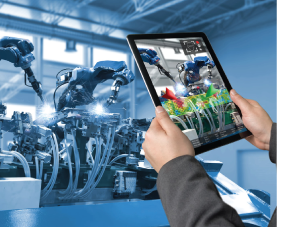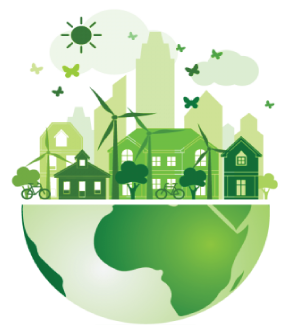IoT & Embedded Technology Blog
A Green Future Demands Digital Twin Cities
Digital twin technology has the potential to revolutionize urban development in a future striving for greener technologies and more efficient energy use. Although the concept has been around since the early 2000s, the practical application of digital twin technology has just begun to sprout in the real world. A digital twin is a simulation of a real life product, service, or process. This virtual model receives data in real time from sensors attached to the process in the real world, allowing decision-makers such as engineers or city planners to more accurately evaluate performance and sustainability of projects.
Urban infrastructure is one use case where the application of digital twins can have dramatic effects. The UN reports that, “cities consume 78 per cent of the world’s energy and produce more than 60 per cent of greenhouse gas emissions.” 55% of the global population lives in urban areas, which is set to increase as the urban population grows by 2.5 billion people by 2050, according to the World Bank. Digital twins will be part of the answer to account for such a drastic increase in urban development effectively, without coming at a great cost to the environment. The scalability of real time data collection can yield unique benefits to this sector.
 Digital twins monitor energy use throughout out the day and during off hours, with analysis of the data identifying points to reduce the use of lighting and thermal systems. Defective equipment can also be recognized in advance of needing timely repairs. Even further, a digital twin could model different reforms over time to measure the effects and long term costs to aid in determining the most optimal solution in energy consumption improvements. This process of collecting data over time and connecting several crucial systems together grants users with the ability to create much more realistic modelling. The integration of historical and predicted power consumption by neighborhood, infrastructure and utility asset mapping, local environmental data, census data, and regional boundaries provides more flexible planning and forecasting.
Digital twins monitor energy use throughout out the day and during off hours, with analysis of the data identifying points to reduce the use of lighting and thermal systems. Defective equipment can also be recognized in advance of needing timely repairs. Even further, a digital twin could model different reforms over time to measure the effects and long term costs to aid in determining the most optimal solution in energy consumption improvements. This process of collecting data over time and connecting several crucial systems together grants users with the ability to create much more realistic modelling. The integration of historical and predicted power consumption by neighborhood, infrastructure and utility asset mapping, local environmental data, census data, and regional boundaries provides more flexible planning and forecasting.
Construction of buildings and energy systems is a costly and time-consuming process. A digital twin will make this process more time and resource efficient, preventing potential mistakes before expensive equipment or products are implemented. Such modelling is also useful in the proposal of costly wind and solar energy projects, where a project’s detailed effectiveness, feasibility, and cost savings can be evaluated ahead of time.
Digital twins are particularly useful in improving wind turbines, which are sometimes volatile due to unpredictable weather conditions. The twin can model a turbine or entire wind farm to determine whether profits would outweigh costs under any number of wind conditions. The twin’s virtual model can also optimize a wind turbine’s placement and test the suitability of its different components. This allows adjustments to be made, such as to blade angles, without any downtime or manual adjustment of the physical turbine. Predictive maintenance is another feature of digital twins to prevent downtime and additional unexpected repair costs. Since the twin takes information directly from the wind turbine, it can be used to estimate the lifetime of each component for adequate planning of maintenance and part replacement.
 In 2019, Integrated Environmental Solutions (IES), a firm who provides building analytics and simulations, undertook its NTU EcoCampus project to create a digital twin of Singapore’s Nanyang Technological University. The first phase of the project began by creating a model of the entire campus with energy signatures for each of the 200 buildings. This was then coupled with an online, cloud based Campus Information Model for communication and engagement with campus staff and students for automatic updates. This information was used to analyze opportunities to improve inefficiencies in energy usage in order to optimize consumption. The thermal performance of these buildings, light sensors, and smart plugs were then improved; yielding a 10% reduction in energy consumption across campus. This ultimately saved the university 3.9 million Singapore dollars ($2.85 million USD) and 8.2 kilotons of carbon.
In 2019, Integrated Environmental Solutions (IES), a firm who provides building analytics and simulations, undertook its NTU EcoCampus project to create a digital twin of Singapore’s Nanyang Technological University. The first phase of the project began by creating a model of the entire campus with energy signatures for each of the 200 buildings. This was then coupled with an online, cloud based Campus Information Model for communication and engagement with campus staff and students for automatic updates. This information was used to analyze opportunities to improve inefficiencies in energy usage in order to optimize consumption. The thermal performance of these buildings, light sensors, and smart plugs were then improved; yielding a 10% reduction in energy consumption across campus. This ultimately saved the university 3.9 million Singapore dollars ($2.85 million USD) and 8.2 kilotons of carbon.
In the second phase of the NTU project, detailed virtual models of 21 buildings were then created. When combined with operational data, IES found more detailed faults. These included low and high CO2 levels, unstable off-coil temperatures, lower than expected return air temperatures, faulty energy consumption meters, as well as temperature setting issues in staff offices and meeting rooms. When selected energy saving technologies were integrated into the model of the buildings, it showed that the university could achieve 31% average energy savings and approximately 4.7 million Singapore dollars ($3.436 million USD) in cost savings per year. (IES)
Singapore was the first city to have a digital twin built to span an entire city’s infrastructure. It was made in 2018 by Dassault Systèmes, allowing the city to predict flood levels, wireless coverage, noise pollution, and even model mosquito breeding conditions. Several cities have already began to implement plans for the integration of a digital twin. The UK recently announced it plans to create a digital twin of Britain’s entire public infrastructure. This is a daunting but extremely beneficial task to help reach its goal of zero net production of greenhouse gases by 2050. Other cities in the process of creating digital twins include Boston, New York City, Paris, Toronto, and Jaipur. Leading companies currently developing digital twins include PTC, Microsoft, Bosch, IBM, and Siemens. Digital twins will have a powerful effect on the optimization of energy generation, storage, and consumption. This will change the process of urban development in a climate that demands improvements be made as soon as possible.
(For more information on development of digital twin technology by PTC and Siemens, see VDC’s previous reports here: Digital Twin - VDC View or Digital Twin, DevOps, and Digital Design Principles for the IoT)